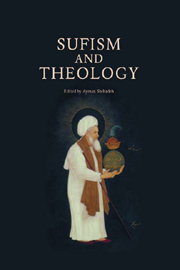Book contents
- Frontmatter
- Contents
- Contributors
- Acknowledgements
- Introduction
- Part I Mystical Theologies
- Part II Theological Approaches to Sufism
- 6 The Mystic and the Sceptic in Fakhr al-Dīn al-Rāzī
- 7 Ibn Taymiyya's Commentary on the Creed of al-Ḥallāj
- 8 Ibn Kemāl (d. 940/1534) on Ibn 'Arabī's Hagiology
- 9 Scriptural Sufism and Scriptural Anti-Sufism: Theology and Mysticism amongst the Shī'ī Akhbāriyya
- 10 Reconciling Sufism with Theology: Abū l-Wafā al-Taftāzānī and the Construct of ‘al-Taṣawwuf al-Islāmī’ in Modern Egypt
- Index
10 - Reconciling Sufism with Theology: Abū l-Wafā al-Taftāzānī and the Construct of ‘al-Taṣawwuf al-Islāmī’ in Modern Egypt
from Part II - Theological Approaches to Sufism
Published online by Cambridge University Press: 12 September 2012
- Frontmatter
- Contents
- Contributors
- Acknowledgements
- Introduction
- Part I Mystical Theologies
- Part II Theological Approaches to Sufism
- 6 The Mystic and the Sceptic in Fakhr al-Dīn al-Rāzī
- 7 Ibn Taymiyya's Commentary on the Creed of al-Ḥallāj
- 8 Ibn Kemāl (d. 940/1534) on Ibn 'Arabī's Hagiology
- 9 Scriptural Sufism and Scriptural Anti-Sufism: Theology and Mysticism amongst the Shī'ī Akhbāriyya
- 10 Reconciling Sufism with Theology: Abū l-Wafā al-Taftāzānī and the Construct of ‘al-Taṣawwuf al-Islāmī’ in Modern Egypt
- Index
Summary
INTRODUCTION
During the middle of the twentieth century Egyptian authors on Sufism discovered the modern science of human psychology as a convenient exegetical tool to harmonise the mystical and theological traditions of Islam. Their psychological explanations of the mystical path, leading to the unio mystica, intended to show that the mystic's unification with God does not, if properly interpreted, contradict tawḥīd Allāh, that is, the theological dogma of God's unique and impenetrable nature. One very influential writer in this respect was the Shādhilī mystic Abū l-Wafā al-Ghunaymī al-Taftāzānī (1930–1994), the author of Ibn ‘Aāṭā’ Allāh al-Sikandarī wa-taṣawwufuh (1969) and Ibn Sab'īn wa-falsafatuh al-ṣūfiyya (1973), books which made him known among Western specialists of the respective subjects. Still almost unnoticed in the West, however, are his immensely popular prolegomena to the fields of Sufism (1974) and theology (1966), in which he, almost single-handedly, created a novel discursive framework in which heterodox Sufi theories could be discussed and defended as fundamentally in line with orthodox doctrine.
Al-Taftāzānī's work represents a very powerful, albeit in the West rather understudied, trend within the Sufi literature of the twentieth-century Arab world: the presentation of Sufism as ‘Islamic mysticism’, where the change from the generic noun taṣawwuf to the attributive compound al-taṣawwuf al-islāmī meant to indicate that Sufism was generically different (to other forms of mysticism) and that it originated from the orthodox (Sunni) norms of the Qur'ān and the Sunna of the Prophet.
- Type
- Chapter
- Information
- Sufism and Theology , pp. 177 - 198Publisher: Edinburgh University PressPrint publication year: 2007



